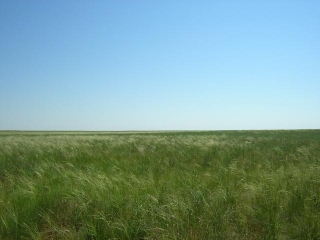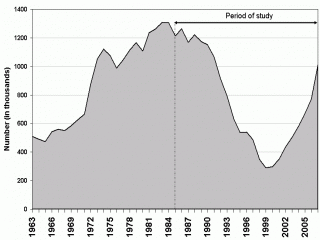Posted 08/9/10
The breakdown of the Soviet Union in 1991 had far-reaching implications, some of which occurred immediately, others following a short time lag, and others we have not yet witnessed. Kalmykia, a rural region of Russia on the shores of the Caspian Sea is an area dominated by livestock grazing. The political shift resulted in strong decline in agricultural subsidies leading in sharp decrease in livestock numbers and thus, grazing pressure, which resulted in recovering vegetation and ultimately an abundance of fuels, which are ready to burn.

Nowadays, wildfire is a regular occurrence in arid grasslands of Kalmykia, Russia. However, landscape analysis of a 23 year period showed significant changes in the fire regime that might be directly linked to socioeconomic changes in Russia during that period. With the fall of the Iron Curtain in 1991, there were socio-economic changes that impacted all of society – from day-to-day life in the big cities to rural farming operations.When a forest burns, the change in the vegetation is dramatic and the recovery is slow. In contrast, effects of wildfires in grasslands are not as conspicuous and recovery happens quickly, often the same year of the fire. These characteristics require novel methods to map wildfires in grasslands accurately. (photo-stipa-green-nonburned and photo-burned-area)

PhD candidate, Maxim Dubinin, has mapped the patterns of fire in this Russian region west of the Caspian Sea. Maxim wondered just what was happening in these arid grasslands and how the collapse of socialism affected landcover. His goal was to quantify how (and whether) fire changed after 1991. To accomplish this goal, he analyzed a series of satellite images between 1985 and 2007, two images per year, one prior to the fire season begins (early spring) and one image after (late summer / early fall). For each year in that time period, he mapped where grassland fires occurred.After 1996 there was a dramatic increase in the area of land burned each year (Figure 1). Maxim and his colleagues propose this is a direct result of the socioeconomic changes. You might wonder how a political shift might result in such a change and why there was a five year time lag? With the socio-economic change, livestock subsidies were eliminated, and farmers could no longer afford to keep their animals (Figure 2). The result was a dramatic decrease in grazing pressure and an abundance of grass that was ready to burn.

Towards the end of the study period, the economy started to grow again and farmers were once again able to support more livestock, resulting in an increase of grazing, and possibly, a decrease in fire as evidenced by Figure 1. It is too soon to tell whether there is a direct link, but with a few more years of data and additional analysis, a trend of further reductions in wildfire activity might become more apparent.This is just one part of the story of fires in Russia. Next steps of Maxim’s project involve a more robust statistical study of causes of such change (including various human and environmental factors) and Maxim studying the changes in vegetation types, especially a shift from Artemisia shrublands to Stipa dominated grasslands, that might have been caused by the more frequent fires.”
Story by Shelley Maxted
